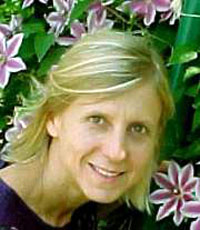|

|
Senior
Biodiversity Specialist
Environment Department (ENV)
Environmentally and Socially Sustainable Development (ESSD)
The World Bank
Washington DC
Ms. Sobrevila is Senior Biodiversity Specialist at the World Bank. A
Venezuelan national, she holds a degree in biology from the Central
University of Venezuela and an M.A. and a doctorate degree (PhD) in
Ecology from Harvard University. During her 10 years at the World Bank,
she has provided technical and project management expertise to projects in
more than 15 countries mainly in Latin America on the establishment and
management of Parks, building ecological corridors, ensuring that
biodiversity conservation is in the agenda of governments, on the
establishment of environment trust funds, and more recently on the
participation of indigenous peoples in biodiversity conservation. She is a
strong practitioner of participatory development. The wide input she seeks
ensures stronger ownership of the decisions by an array of interest groups
and may ensure more long-lasting effects in conservation. Ms. Sobrevila
has led workshops to develop best practices on the issue of the role of
indigenous peoples in biodiversity conservation, on traditional knowledge
of indigenous groups and on long-term innovative financing mechanisms for
protected areas.
Prior to her position at the Bank, Ms. Sobrevila was Chief Ecologist at
The Nature Conservancy, where she did inventories of vegetation types and
park planning in more than 8 countries and developed a Manual for Rapid
Ecological Assessment that is being used commonly in Latin America. She
was also Senior Director for the Andean Countries at Conservation
International, where she promoted the concept and development of
ecological corridors, particularly in the Peru-Bolivia Amazon Lowlands,
which has become a major conservation strategy in these two countries.
Ms. Sobrevila has authored several papers and reports on rapid ecological
assessment, ecological guide to a park, conservation planning tools,
biodiversity conservation and more recently on the role of Nature and
Peace. Recently, Claudia founded a non-profit organization “EcoVillages
Foundation-Peaceful people in a Healthy Environment” to support poor
indigenous communities in remote villages in Tibet and in the rain forests
of South and Central America.
The importance of preserving sacred sites
for the well being
of human beings
Since the dawn of humanity, certain places have being recognized as sacred
and containing special qualities where humans can experience a different
consciousness, inner peace, and a larger space of their own human
existence. Ancient civilizations gave a lot of importance in their
societies to respect and make these sites part of their culture. They were
more prominent, regularly used and people depended on them more than in
our modern societies.
These ancient cultures were rich in spirituality and human values such as
devotion, reciprocity, respect, equanimity and many other higher purpose
values. These sites were places that cultivated and strengthened this
spirituality and human values. For some cultures, these sites could be a
temple or religious edification that reminded them of the spirit world,
but in other cultures, such as the indigenous groups that lived in natural
environment and in the rain forests, they also designated special lakes,
mountains, etc.. as sacred sites within their territories. But, also for
many indigenous cultures, all elements of nature were sacred, their lands,
their crops, their daily activities, their animals, plants and rivers,
etc…
Even today, societies designate certain places that they consider sacred,
such as churches and temples. Their behavior in these places is different
from the one they have outside these sacred sites. They maintain silence,
are respectful and behave differently. This is very positive. However
there are very few sites considering the large population densities that
we have reached and also a large portion of society do not visit these
sites or they do not have a special connection to any sacred sites as a
place to connect with their own spirit and with other subtle levels of
human existence. In many societies, the sacredness of these sites is being
lost, like when people visit ancient pyramids and old temples, they might
not be able to experience the great spiritual presence in the site that
could heal them and improve their lives.
During this talk, I would like to explore the importance that sacred sites
have to the well being of humans. I would like to suggest that it is as
important to preserve more places outside, but also it is as important to
increase our capacities to experience the values that these sites provide
to our own personal lives and health. I would also like to bring a new
concept and that is that, during these times of degeneration that we are
living, environmentally pure places might be the most important sacred
sites to preserve, as they are strong sources of spiritual energy. I just
learned from the ancient Inca Civilization that there is an important
natural law that they applied to their sacred sites and that is the law of
reciprocity. Reciprocity is that we don’t just go to a sacred site to ask
for something that will bring us benefits and well being, but we also
bring gratitude, offerings, and promises of taking care of the sacred.
If we are able to increase the presence of sacred sites in our physical
world to counteract the many areas developed without any presence of
spirit or human values, we will already have done something useful. If we
also increase our way of interacting with these sites and our capacities
to experience the power of these sites, we will perceive increased
benefits for our own well being and for our communities and society. And
finally, if we are also able to bring the sacredness from these sites to
our home, work, communities and to our daily interactions, we will have
created an enlightened society! |